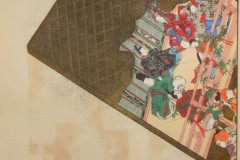[Omocha-e. 玩具絵].Shimizu Seifū. 清水晴風. Unai no tomo (Children’s Friends [Japanese toys]). Volume 1 [alone].うなゐの友 初編. [Kyoto], Unsodo, Yamada Naosaburo, Meiji 24 [Octobre 1891]. 芸艸堂, 山田直三郎, 明治廿四年 十月. In-8° (25,2 x 17,5 cm) . 62 leaves, 52 full-page prints (which 2 double-page) colored, some on a gold or silver background, some under serpentes. Sewn, original cover with embossed patterns, glued title label.
Rare first volume, first printing, of a production that will count 10 volumes and whose edition will end in 1924, Tekiho Nishizawa (西澤笛穗) taking over the editorial succession after 1913. One of Unsodo’s very first publications, art publishing house founded in 1891, printed by Kimura Tokutaro (仝木邨德太郎). Dolls, rattles, whistles, rackets, hairpins, etc.
Shimizu Seifū (1851-1913), student of Utagawa Yoshikane (歌川芳兼), disciple of Utagawa Kuniyoshi’s disciple (歌川國芳) , was one of the most famous artists of Omocha-e, prints from the playworld. In 1889, he recreates scenes of childhood play with his childhood friends and creates the Bamboo Equestrian Club (竹马會). It was on this occasion that he decided to collect and research toys after seeing many old ones from all over the country.. In 1894, he participated in the founding of the Tokyo Antiquities Association (集古會). Initially, the association focused only on displaying archaeological artifacts and calligraphy., and it was at Shimizu’s suggestion that a department for the toy collection was added.. In 1904, he organized the first known exhibition of Japanese folk toys in Ueno and Okazaki, the Kodomo Hakurankai (exhibition for children), exhibiting many toys from his own collection. In 1909, he exhibited his toys at the children’s exhibition sponsored by Mitsukoshi Gofukuten (三越呉服店) in Tokyo. Further, taking advantage of the Mitsukoshi exhibition, he created the Tokyo Toy Research Association (東京玩具研究会) with academics related to children’s education and strove to set up toy education.
Passionate collector of popular Japanese toys, his illustrations serve as both artistic and ethnographic references in which many Japanese artists have found their inspiration., including those of the Mingei movement. Unai no tomo remains the definitive illustrated book on Japanese folk toys and is the most important illustrated book on the subject since the eighteenth century., a true “bible” for collectors, after Kyburz.
Rubbed cover and title, book sewing lost down ; the prints are remarkably fresh.
Rare copy.
900 €











